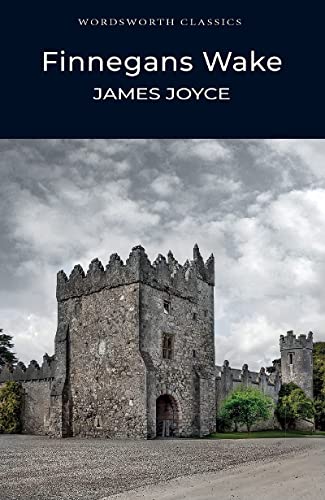Alright folks, buckle up! This is my review of Finnegans Wake. It’s the kind of book that makes you feel like you’ve fallen into a rabbit hole with Alice, but instead of Wonderland, you get a strange, dream-like universe full of complex narrative loops, mind-bending language styles, and a mix of historical and cultural references. The characters evolve in ways that will make your head spin, and let’s not forget those moments when you’re tempted to use the book as a doorstop! But don’t worry, I’m here to help you navigate through this literary rollercoaster. Hold onto your hats!
In a Nutshell
Finnegans Wake, penned by the brilliant James Joyce, is a challenging work of modernist literature. The book dives deep into themes of dreams, cycles of history, and the complexity of the human experience.
Through its unique language and narrative structure, Joyce takes readers on a whirlwind journey. The prose is filled with puns, made-up words, and multi-layered meanings. It can be a bit of a brain workout, but oh boy, it’s worth it!
The novel also blends myths, history, and folklore, making it a treasure hunt for references and hidden meanings. It’s like an intricate puzzle that rewards you the more you dig in.
The Whirlwind of Complex Narrative Structure in Finnegans Wake
James Joyce’s Finnegans Wake is like trying to read a book while riding a rollercoaster blindfolded. The narrative structure is so complex, it’s a miracle anyone gets through it. I once tried reading it on a lazy Sunday afternoon, thinking it would be a breeze. Spoiler alert: it wasn’t. Instead, I ended up with a headache and a newfound respect for anyone who claims they’ve read it cover to cover.
The story doesn’t follow a straight path. Oh no, that would be too easy! Instead, it loops, folds, and flips like an origami crane. One minute you’re reading about a family in Dublin, the next you’re in a dream sequence with puns that would make Shakespeare blush. It’s like Joyce took a box of narrative threads, threw them in the air, and decided to write where they landed.
If you’re looking for a linear plot, you might want to pick up another book. But if you’re up for a challenge, Finnegans Wake might just be your Everest. Sure, it can be frustrating. Who doesn’t love a book where a single sentence takes up an entire page and you still have no idea what’s happening?
The best part? You can read it multiple times and find something new each go-around. It’s like Joyce sprinkled magical mind-bending fairy dust throughout the pages. One moment, you think you’ve grasped the plot, and the next, you realize you’re as lost as you were on page one.
Hold onto your hats because next up, we’re diving into the unique language style that makes Finnegans Wake a puzzle wrapped in an enigma.
Unique Language Style in Finnegans Wake
Ah, Finnegans Wake! This book, by James Joyce, is the ultimate brain teaser. Its language is like a bizarre buffet of words. You’ve got English, you’ve got puns, you’ve got other languages mixed in, and sometimes it feels like you’re decoding a secret message. It’s like Joyce threw the dictionary into a blender and hit puree!
Imagine reading through a fog of metaphors and puzzles. The sentences twist and turn like a twisty slide at a playground, but instead of fun, you get a splash of confusion. But, trust me, it’s worth it. The language in Finnegans Wake is an experiment in itself. It’s like Joyce was trying to invent a new way to communicate, and in a way, he succeeded. It’s almost like a cross between poetry and prose, or even something else entirely.
One of my favorite parts is how Joyce makes up new words. It’s like he’s created a language from scratch. He blends words together, uses portmanteaus, and sometimes, it seems like he’s just playing a game. You need to be ready to switch gears constantly. Reading it out loud feels like you’re casting spells from a magical book.
However, this unique language style does come with some downsides. It can be tough to follow the plot, or even tell if there is one sometimes! You might find yourself re-reading the same sentence multiple times, trying to grasp its meaning.
But hey, that’s part of the fun, right? Now, let’s move on to the rich tapestry of historical and cultural references woven into the text. Buckle up!
Historical and Cultural References in Finnegans Wake
Let me tell you, tackling Finnegans Wake is like trying to eat spaghetti with a single chopstick. James Joyce didn’t hold back on weaving layers upon layers of historical and cultural references. You’ll find nods to ancient myths, European history, and more modern events scattered throughout the text like Easter eggs. And don’t get me started on his references to Irish folklore; it’s like he made a Guinness-fueled pact with every leprechaun in the land!
Take the character HCE, for instance. He reflects figures like Adam, Charles Stewart Parnell, and even King Arthur. Joyce casually flings these historical personas into his narrative like an over-enthusiastic pizza chef tossing dough. The book’s title itself is a play on an old Irish ballad, Finnegan’s Wake, which adds another cultural layer.
Of course, for us mere mortals, these references can be both a pro and a con. On the plus side, the book is like a treasure hunt for history buffs and culture vultures. On the downside, you might need a PhD in everything to catch them all. Sometimes I felt like I was cramming for a final exam, trying to decode everything. But hey, challenge accepted, right?
This kaleidoscope of references may leave you scratching your head at times, but it also makes re-reading the book a new experience every time. Just like peeling an onion, but with more tears and aha moments.
Alright, now that we’ve navigated through the historical labyrinth, let’s jump into the quirky world of character development and interactions in the next section.
Character Development and Interactions in Finnegans Wake
Let’s talk about the characters in Finnegans Wake. James Joyce serves up a platter of characters that are as slippery as a bar of soap in a bathtub. The book starts with Humphrey Chimpden Earwicker, our everyman, who may or may not be the reincarnation of a mythical giant. Then there’s his wife, Anna Livia Plurabelle, who’s practically the River Liffey in human form. These characters aren’t your typical next-door neighbors. They morph, blend, and interact in ways that make you wonder if Joyce was eating too much magic beans.
Their interactions are like a game of charades—loaded with hints but miles from straightforward. Ever tried explaining the plot of a soap opera to someone who only speaks Klingon? Welcome to Finnegans Wake. The dialogues are cryptic, stuffed with puns, allusions, and multilingual jokes that could make a polyglot faint. One moment they’re in Dublin, the next they’re in some mythical landscape.
Now, this sounds like a hot mess, and in a way, it is. But that’s also where the magic happens. Each re-read unveils something new about these characters and their complex web of relationships. It’s like peeling an onion that regenerates every time you think you’ve reached the core.
So, do I recommend Finnegans Wake? That’s like asking if you should try skydiving. If you’re up for a wild ride that makes you scratch your head and laugh out loud at its sheer audacity, then absolutely, go for it!
Conclusion
So there you have it, folks. Finnegans Wake by James Joyce is like a rollercoaster ride for your brain. It’s got a complex narrative that’s harder to navigate than IKEA instructions, a unique language style that’ll make you think you’ve stumbled upon a linguistic treasure hunt, and more historical and cultural references than your high school history book. The characters are like chameleons, constantly changing and evolving, which keeps things interesting but can also be a bit bewildering at times.
In short, if you’re up for a challenge and love digging deep into your reads, Finnegans Wake might just be your next favorite book. But if you’re looking for something light and easy-going, you might want to give this one a miss. Happy reading!


